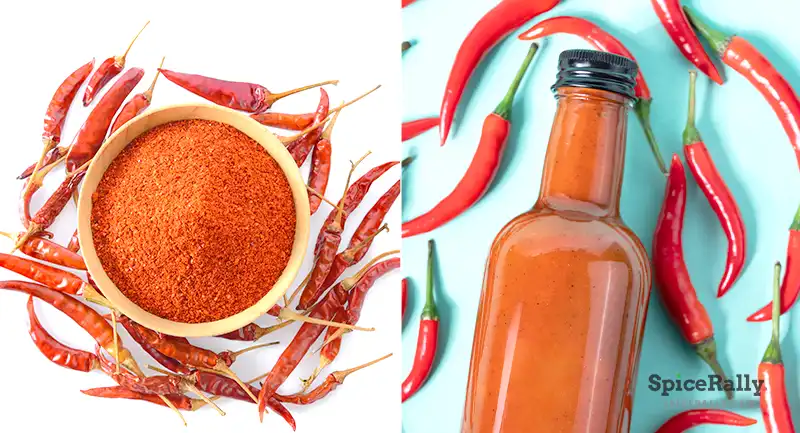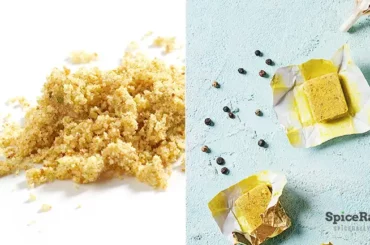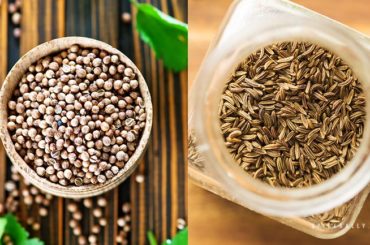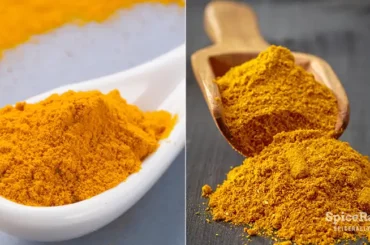Cayenne pepper is a well-known, widely used spice in many parts of the world for its piquancy and beautiful color. So, in this post, let’s have you covered with the best cayenne pepper substitutes.
Cayenne pepper replacements can be categorized as:
Accordingly, whole chilies like serrano, tabasco, Aji Amarillo, etc., work as fresh alternatives, while hot paprika or red chili flakes can be used as dry substitutes. And also, Tabasco sauce and a few other types of hot sauces could also replace the flavor and color of cayenne pepper in certain dishes.
So, read further to understand what and how much cayenne alternative to use in your regular dishes.
The Best Cayenne Pepper Substitutes
Cayenne peppers are a prevalent spice around the Western hemisphere and are known for their heat, piquancy, and color rather than flavor. This chili pepper is considerably hot, ranging from 30000- 50000 SHU on the Scoville Heat Scale. You can find a variety of cayenne peppers, such as:
- Cayennetta
- Red ember
- Red flame
- Joe’s long cayenne
- Large red thick
- Ring of fire
- Buena mulata
The most common form of using this pepper is in its ground form, while some recipes also call for fresh chilies. Accordingly, we should particularly consider the heat level and the color when choosing an alternative. So, check out the list below and pick what is best and most convenient for you whenever cayenne pepper is out of hand.

Fresh Cayenne Pepper Substitutes
Fresh cayenne peppers are primarily used in salads, pickles, pastes, sauces, etc. So, if you don’t have it around, try using one of these alternatives for a similar effect in your dishes.
- Tabasco Peppers
- Serrano Peppers
- Thai Peppers
- Aji Amarillo Peppers
- Super Chili Peppers
- Chile de Arbol
01- Tabasco Peppers
If you are looking out for a similar heat and color to cayenne pepper, tabasco pepper could be your best bet. Tabasco pepper also possesses a heat level ranging from 30000- 50000 SHU, equivalent to cayenne peppers.
However, tabasco peppers can be juicier than our topic leader, so you’ll experience a bit of the difference in texture. But still, they will work perfectly well with sauces, salsas, and any other recipe that calls for a bit of moisture.
02- Serrano Peppers
This type of chili pepper can be a little less intense and less hot than cayenne peppers, scoring 10000- 25000 SHU on the Scoville Heat Scale.
But still, it will be a possible alternative for any dish that calls for fresh cayenne peppers if you pick the red serrano chilies. Since these chilies are milder than our topic leader, you can either use the same amount or a little more than you would usually use.
03- Thai Peppers
Generally, there’s a wide variety of Thai peppers, ranging from 50000-100000 SHU. These chilies are widely used in most Asian curry pastes, sauces, and salsas. They are pretty common if you visit the supermarket and can definitely be found in Asian stores.
However, the heat level of Thai peppers can be similar to that of a cayenne pepper variety that is the hottest. Or else, most Thai peppers can be about two times hotter than cayenne peppers but still can be a decent choice for recipes where you don’t mind a bit of extra heat. So, if you get a hotter variant of this alternative, make sure to use it mindfully.
04- Aji Amarillo Peppers
This is a chili pepper type that is commonly used in Peruvian cuisine. They have a similar SHU to that of cayenne but are different in color since Aji Amarillo peppers are usually yellow or bright orange. But, if you happen to come across these peppers when you can’t find cayenne pepper, we recommend this as a good substitute if you don’t really care about the color difference it could give your dish.
In addition, they also can be fruitier than our topic leader so that you’ll have a different flavor experience in your plates! So you can decide the amount you use since they are similar in heat, and they’ll be good to go with sauces, pickles, pastes, gravies, etc.
05- Super Chili Peppers
These beauties are definitely a great pick whenever you can’t find fresh cayenne peppers around! They pack a punch with a heat scale ranging from 40000-50000, which is equivalent to that of our topic leader.
Super chili peppers are considered ornamental peppers, and they possess a multitude of colors. So, if you need a similar visual effect, you can choose red super chilies to replace cayenne peppers, especially in highly spiced Asian dishes.
06- Chile de Arbol
This is another possible cayenne pepper substitute you can easily find in the Mexican aisle of the supermarket. You may find fresh Chile de Arbol peppers, commonly sold as dried peppers. These chili peppers pack a serious punch of heat, just like our topic leader, which scores around 15000-30000 SHU on the Scoville Heat Scale.
However, most Arbol chilies are milder than cayenne pepper, so you will have to use more than the usual amount when substituting. If you get dried Chile de Arbol peppers, you can use them to replace dishes like soups, curry pastes, and sauces.
Ground Cayenne Pepper Substitutes
Powdered or ground cayenne pepper is the most common type we tend to add to our dishes since it is super blendable and versatile. Ground cayenne pepper is typically used in a wide variety of spicy, savory, and even sweet dishes or beverages. So, here’s a list of substitutes that could be used in place of our topic leader.
01- Red Chili Flakes
Most red chili flakes are made with dried, crushed cayenne peppers. So, no wonder why it becomes an excellent substitute for cayenne pepper, isn’t that so? You might get a slight difference in texture since red chili flakes are coarser and chunkier.
So, if you don’t mind the visual effect and the subtle texture difference, go with this replacement in anything that originally calls for ground cayenne. You can use the same amount at the beginning and adjust according to taste.
02- Hot Paprika
This option is readily available and might already lie in your spice cabinet. Hot paprika could be milder than ground cayenne. But still, it offers the perfect color and flavor match to that of our topic leader. So, when you need to substitute, use twice as much cayenne pepper powder and then adjust the amount as needed.
Click on this link to discover the real difference between paprika and cayenne pepper.
03- Chili Powder
Most chili powders sold at the Western market are usually a blend of several spices like red chili powder, garlic powder, ground cumin, etc. And some options might also contain salt. Therefore, this alternative could add a bit of complexity to your dishes than cayenne pepper normally would do.
Nevertheless, you can expect to have a similar heat level and color. Moreover, you can also find some chili powder varieties from the Asian market that are purely made out of ground chilies. They do not usually include any other additional spice. Hence, these variants can also help give a similar effect as ground cayenne.
So, when using any of these, you can start with a small amount and then increase the amount according to your preference. Chili powder can be used in any dish that originally calls for ground cayenne as a secondary element.
Saucy Cayenne Pepper Substitutes
Some decadent recipes call for fresh or ground cayenne pepper, but a saucy option would also work well in them. In such instances, here’re some readily available options that’ll help you to save a dish or two when our topic leader is not in hand.
- Tabasco Sauce
- Frank’s RedHot Original Hot Sauce
- Melinda’s Louisiana Red Cayenne Hot Sauce
- Crystal Louisiana’s Pure Hot Sauce
01- Tabasco Sauce
Like fresh tabasco peppers work as an excellent first choice in place of fresh cayenne, tabasco sauce could also be used in many dishes. It provides a similar heat and color with a deep, rich flavor.
Other Types Of Hot Sauces
There are several other hot sauce types in the store made with cayenne peppers in addition to tabasco sauce. Accordingly, you can go for options like Frank’s RedHot Original Hot Sauce, Melinda’s Louisiana Red Cayenne Hot Sauce, or Crystal Louisiana’s Pure Hot Sauce.
These hot sauces include cayenne pepper as their primary component; therefore, you could spice up your dishes without feeling guilty about the absence of the original ingredient. However, keep in mind that these sauces could contain additional flavorings like vinegar, garlic, etc., so it is always better to start with a small amount and then proceed.
Final Words About The Cayenne Pepper Substitutes…
If not having cayenne pepper around to make our favorite spicy dish ever bothered you, we hope we’ve got you covered with the best substitutes that’ll come to your rescue!
Other fresh chilies like tabasco, serrano, Thai peppers, etc., can give a similar effect in the dishes that call for fresh cayenne peppers, while hot paprika, red chili flakes, or chili powder could cover up the recipes that require ground cayenne. In addition, you can also use complex options like tabasco sauce or several other hot sauce types to compare the flavor, heat, and color you usually get from this robust spice.
This post may contain affiliate links. If you use these links and make a purchase, We may earn a small commission. However, there’s no extra cost to you. Also, as an Amazon Associate, we earn from qualifying purchases. Thanks!




